England-Australia Flights
-
-Flight - EA 1932
England-Australia, 1932 (solo).-C.W.A. Scott on a D.H. Moth ("Gypsy II").
Left Lympne April 19. Reached Port Darwin April 28. 8 days 20hr 47 min. Record. -
-Flight - EA 1933 CKS
England-Australia 1933 (solo).- C.E. Kingsford-Smith on a Percival Gull ("Gipsy Major").
Left Lympne Oct 4. Reached Wyndham Oct 11.
7 days 4hr 44min. Record.

-
-Flight - EA 1933 JB
England-Australia (solo) 1933 -Jean Batten
Left Lympne May 9th. Arrived Darwin 24th May 1934.
14 days 23hr 25min. Record.
Jean had tried the journey the previous April, but had crashed (twice) near Karachi, the second time writing off the aeroplane.
On her second attempt in April 1934, she also had a forced landing near Rome (escaping with a cut lip, and shock), and returned to England.

-
-Flight - EA 1933 VH-UXX
1933 - C. T. P Ulm, G. Allen, and P. Taylor (Avro " Ten " ) : Harmondsworth to Derby (Australia)
6 days 17 hr. 45 min. Record.Scotty Allan, Charles Ulm, P.G. Taylor and J.A.W. Edwards in front of Faith in Australia, Avro X monoplane VH-UXX at Heston Aerodrome, England, 25 July 1933

-
-Flight - EA 1934

Australia-England 1934.-Bernard Rubin and Ken Waller in a D.H. Leopard Moth.
April. 8 days 12hr. Record
-
-Flight - EA 1934
England-Australia 1934 - C.W.A. Scott and T Campbell Black. MacRobertson Race.
Record.

-
-Flight - EA 1934 CJ
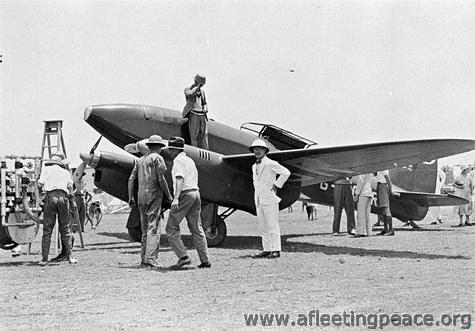
Australia-England 1934 - O. Cathcart Jones and K.F.H. Waller.
Left Melbourne 09:10 a.m. October 28. Delayed by bad weather in Athens. Arrived Lympne 1:12 p.m. 2 November.
6 days 16hr 10min. Record.
Owen said "We have averaged 10 hours flying every day, and covered approximately 2,200 miles a day. We wanted to make this flight back not so much as a speed flight, but as a flight which could be copied for commercial purposes" -
-Flight - EA 1935
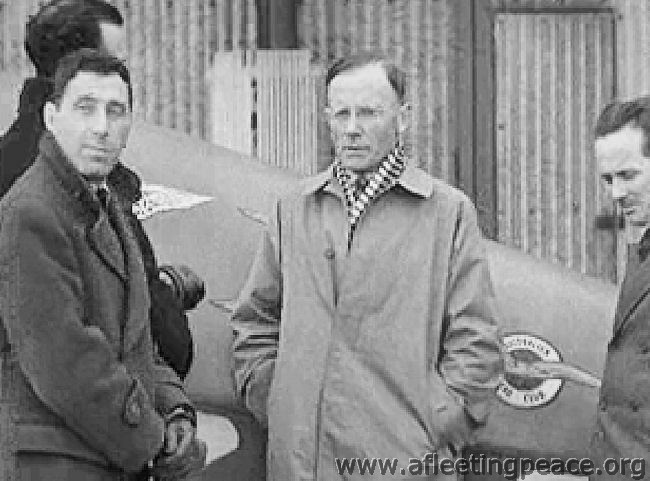
Australia-England (solo) 1935- H.L. Brook in a Miles Falcon.
March.
7 days 19hr 50min. Record.
Harold "I'm not a 38 year old accountant" Brook explains to a less-than-fascinated audience that "Flying to Australia is not the er, terrible thing that um, a lot of people seem to, seem to suppose it is, although it naturally requires a good deal of careful preparation and, erm, or-organisation. This is, this is um, this is the machine I used in, in the air race but unfortunately we didn't um... we didn't um..." [zzzz]
-
-Flight - EA 1935 Broadbent
England-Australia 1935 -H F Broadbent. 6 days 21hrs 19min. Record.
On 2 November 1935, he took off from Croydon in Percival Gull Six (VH-UVA) in an attempt to break the England to Australia record, which he achieved after arriving at Darwin after 6 days 21 hours 19 minutes.
He was awarded the Oswald Watt Gold Medal for 1935
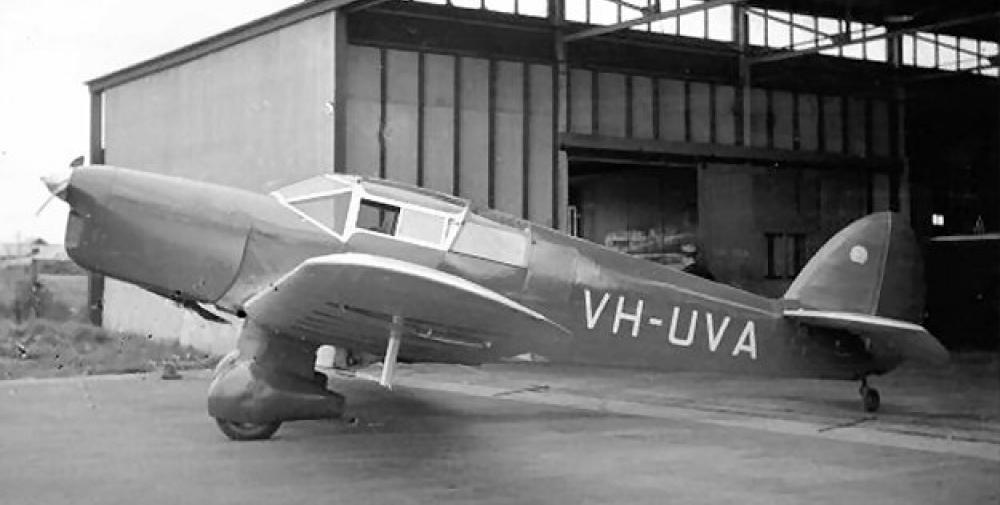
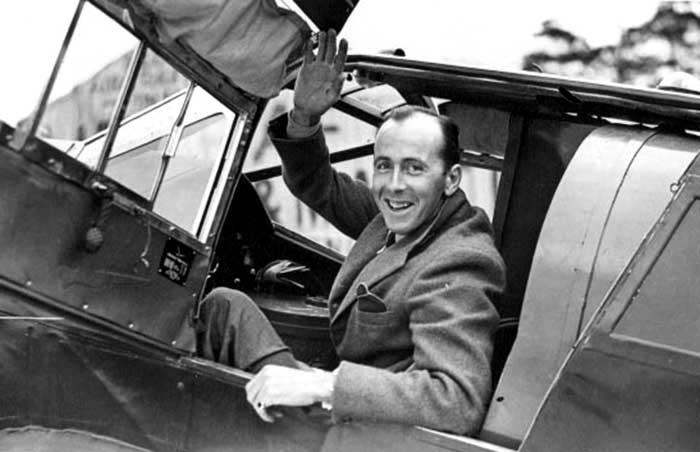
-
-Flight - EA 1935 JB
Australia-England 1935 (solo).- Jean Batten. April. 17 days 16hr 15min. Record. -
-Flight - EA 1936 JB
England-Australia 1936.-Jean Batten. 5 days 21hrs 3min. Record. -
-Flight - EA 1937 HB
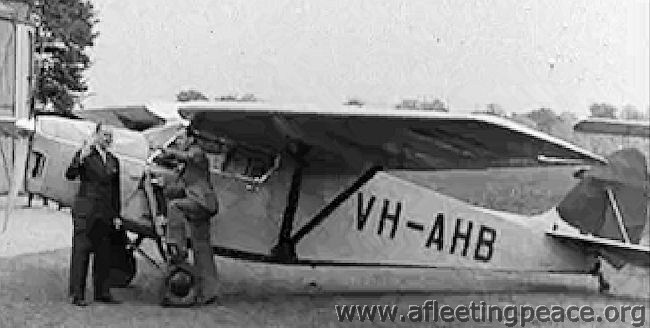
Australia-England 1937 (solo)
H F 'Jim' Broadbent in a D.H. Leopard Moth.
May
6 days 8hrs 25min.Record.
-
-Flight - EA 1937 JB

Australia-England 1937 (solo).-Jean Batten in a Percival Gull.
October.
5 days 13hr 15min. Record. -
-The Aviators
The Aviators
-
Batten, Jean Gardner
Jean Gardner Batten
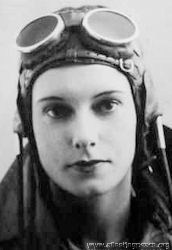 in 1930
in 1930b. 15 September 1909 in Rotorua, New Zealand, a "shy, determined girl".
"By the time I was nineteen I knew my future must be in flying." Studied music from a young age but, having passed the Royal Academy of Music Finals, she sold her beloved piano to get to England and pay for flying lessons.
One of the most spectacularly successful aviators of the early 30s; after her solo flight from England to Australia in 1934 (at the third time of trying) the New Zealand Govermnment awarded her £500 in recognition of her feat. She was in Melbourne a few months later to greet Scott and Campbell Black as winners of the MacRobertson Race, and left Sydney the following April to fly back to England, but didn't quite beat her record.
In November 1935, came her real breakthrough: she flew to Brazil and beat the South Atlantic crossing record, taking 13 hrs 15min in her Percival Gull.
This time, she was awarded:
- the Order of the Southern Cross (by the Brazilians);
- the Gold Medal of the French Academy of Sports;
- the Brittania Trophy (by the Royal Aero Club);
- the C.B.E. for 'general services to aviation';
- the Legion d'Honneur (the French seemed to like her, for some reason);
- the Johnson Memorial Prize (from the Guild of Airline Pilots and Navigators), and
- she was guest of honour in Paris at the Aero Club de France.
In October 1936, having attended literally dozens of receptions and award-giving ceremonies, she set off once more, this time to fly to New Zealand in her Percival Gull. On the way, she beat Harry Broadbent's record solo time to Australia, despite a puncture in the tail tyre which a helpful aerodrome official repaired by stuffing it with face sponges.
Just as Scott and Guthrie were returning rather sheepishly from the miserable Schlesinger Race to Cape Town, Jean was getting ready to fly from Australia to New Zealand. She arrived there on October 17th, met by large and enthusiastic crowds; the first woman to cross the Tasman Sea, the first direct flight from England to New Zealand.
On the last day of 1936, however, Jean's South Atlantic record was beaten by another woman - Mme Maryse Bastié.
In 1937, Jean again won the Brittania Trophy, the Harmon Trophy, and the Segrave Trophy for her 1936 flight. In October she set off for England again; at one stage, she was heading west, trying to beat Harry Broadbent's record, as Harry Broadbent was heading east, trying to break her record. She won; Jean beat Harry's record, while he had to give up at Basra. "I confess I am fed up", he said...
Jean picked up yet more awards; the Gold Medal of the Royal Aero Club; the Gold Medal of the F.A.I. (no less); summoned to Buckingham Palace to meet the King and Queen of the Belgians (exciting); immortalised in Madame Taussaud waxworks (until they melted her down, at least), another round of receptions as guest of honour...
But her brief time in the spotlight was coming to an end. Harry Broadbent took back his Australia-England record; Arthur Clouston and Victor Ricketts more than halved her England-New Zealand record time in 1938. She still attended dinners and receptions in her honour; she wrote her autobiography (called, rather disappointingly, 'My Life'), but she made no more record attempts. Even so, her remaining record, solo to Australia, stood for over 40 years.
In WWII she toured the country as part of the 'Wings for Victory' campaign, giving dozens of lectures anywhere between Manchester and Penzance.
Her Percival Gull, G-ADPR 'Jean' was presented to the Shuttleworth Trust on 26 April 1961, having been requisitioned by the RAF in WWII and then returned to Hunting Aircraft. However, by 1969 it needed major repairs and was grounded until 1978. Jean herself offered to come back from Tenerife to help: "I used to be quite good at stitching canvas on wings". It was sold in the early 90s (when Shuttleworth was strapped for cash) and is now on display at Aukland Airport:
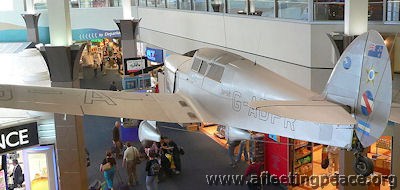
In 1980 she and Edgar Percival were made liverymen of the Guild of Airline Pilots and Navigators, and she then travelled to Hull to open the 'Silver Wings' exhibition, in honour of Amy Johnson.
Jean Batten owned:
a 1929 DH.60G Gipsy Moth, G-AALG, which she flew to New Zealand in 1933;
a 1929 DH.60M Moth, G-AARB, in which she broke the England-Australia record in 1934, and was later owned by Gabrielle Patterson, R Gordon and BK Lyall (simultaneously, that is), and later,
a 1933 DH.60G III Moth Major, G-ACKF.
She died in 1982 in Majorca.
-
Broadbent, Harry F J
Mr Harry F J Broadbent
 photo: 1937, aged 27
photo: 1937, aged 27Australian record-breaker (solo round-Australia record in 1931), born 1910.
Listed polo, tennis, golf and cricket among his other pastimes.
-
Brook, Harold Leslie
Harold Leslie Brook

b. 11 October 1897, in Bradford
Only learnt to fly in 1933, and just scraped up the minimum 100hrs solo flying time required to enter the Race. The aircraft was barely ready in time either; a month before the start it didn't have any seats, and was in "a very unfinished condition". Harold was not impressed by "those fools at Reading [i.e. Miles Aircraft]... this is not the first time they have omitted to do something".
In March 1934, he tried to break the England-Australia solo record (held by CWA Scott) but only got as far as the Cevennes before crashing into one of the large mountains they have there. To give him his due, he picked up the important bits of his aeroplane, brought them back and used the engine in this Miles Falcon.
In 1935, after taking part in the MacRobertson, he flew back from Australia in record time; you might like to see him talk about his record-breaking flight (on the other hand, you may have some drying paint that needs watching); if so, click Record Flight From Australia - British Pathé (britishpathe.com)
Two years later, he added the Cape Town record. Mercifully, there don't appear to be any interviews about this one.
Pilot Officer in the Administrative and Special Duties Branch in May 1940, then briefly (28 Oct 1940 - 3 May 1941) in the Air Transport Auxiliary (ATA)
And, despite what you may read or hear, was never an accountant in his life (although with his spectacles on, he did rather look like one, and when he talked, he did rather sound like one [sorry]), and he signed himself 'Brook', not 'Brooke'.
But 'e were definitely from 'Arrogate.


H. L. BROOK writes to TERRY'S
Dear Sirs,
I should like to take this opportunity of congratulating you on the excellence of your Springs in my Gipsy 6 Engine. In a record-breaking flight of this description the engine has to be run for long periods in extreme temperatures, and at a higher rate of revolutions than normal, and for a valve spring to break would spell disaster. I had never at any time any fear of this happening with your springs, and they are now at the end of the flight in just as good condition as they were at the start.
Yours faithfully,
(signed) H. L BROOK.
'Flight'
Racing No. 31—H. L. Brook, and —?
And speaking of Bradford, here is Harold Leslie Brook, who was born there in 1897, and now resides in Harrogate. He joined the Royal Field Artillery on August 20, 1914, at the age of 16, obtained his commission soon afterwards, and, despite a couple of wounds, served five years in France and India.
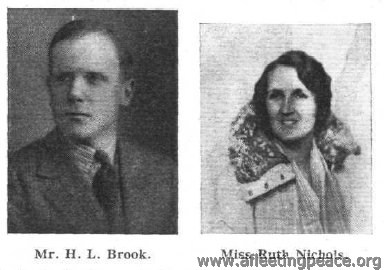
Restored to his family, he remained a normal civilian until Yorkshire began to build and fly sailplanes and gliders. These occupations kept him mildly diverted until the approach of his 37th birthday. Then he began to yearn for horse-power. The York County Aviation Club at Sherburn-in-Elmet offered a likely fulfilment of this secret ambition. So, in August, 1933, Brook placed himself in the hands of Instructor Cudemore, and after four hours' instruction became a soloist with serious designs on the MacRobertson Handicap, for which Phillips and Powis have built him the first of their Miles 'Falcons'.
What happened between last autumn and this spring is now almost historic. Brook bought the "Puss Moth" (Heart's Content) in which the Mollisons had crossed the Atlantic, and, with a total of 43 hr. in his logbook, pushed off solo from Lympne to survey the route to Melbourne. That was on March 28, 1934, at 5.20 a.m.
By noon the incident had closed. Describing it a few days later Brook said that, while flying through very dirty weather over France, he was forced down from 12,000 ft. by ice formation on the wings, and, before he knew how or why, the side of an unsuspected mountain was rushing up at him out of the murk. Guided by some uncanny sixth sense, he brought off a bloodless landing on the mountain proper. The scene of this epic of the air was Genolhac, in the Cevennes. With some local help he salvaged the "Gipsy Major," brought it back to England, and has had it installed in Heart's Content II.
Brook's next attempt on the Australian record will not be solo. If expectations are realised, he will be accompanied by two lady passengers.
'Flight'
Another England-Australia attempt
MR. H. L. BROOKE, a member of the York County Aviation Club, left Lympne at dawn on the morning of Wednesday, March 28, on an attempt to break the record for the England-Australia trip held by Sir Charles Kingsford-Smith with the time of 7 days 3 hours. Mr.Brooke was flying the " Puss Moth " (" Gipsy III ") Heart's Content, in which Mr. J. A. Mollison made an Atlantic crossing. A few hours after leaving Lympne, while flying through fog, he crashed in deep snow near Genholac, in the Cevennes. The machine was completely wrecked, but Mr. Brooke escaped with nothing worse than some bad bruises. For five hours he wandered about inthe mountains, and eventually found a small village, where he was given every attention. Later he returned to the wreck of his machine, and removed the instruments and other articles of value.
'Flight'
April 4, 1935
YORK COUNTY AVIATION CLUB, SHADWELL, LEEDS
During March the York County Aviation Club, Ltd., flew 63 hours at Sherburn-in-Elmet, and Miss Maurice and Mr.Pilkington made first solos. Two machines flew to Nottingham for the club dance, and Mr. Humble, the honorary instructor, has presented the club with a fire tender—a very apposite gift! The next dance will be held on April 13.
Mr. H. L Brook, who has just broken the Australia-England record with a Miles " Falcon," was trained at Sherburn—which appears to be a pretty good advertisement for the instruction.
'Flight'
These days, the home of Sherburn Aero Club: http://www.sherburn-aero-club.org.uk/
SWIFTLY from AUSTRALIA
How H. L. Brook, in a " Gipsy "-engined Miles "Falcon" broke the Solo Record : His Story in an Interview with " Flight
"LAST Sunday afternoon, at 3.55 p.m., the original Miles" Falcon " landed at Lympne, having flown in 7 days•* 19 hr. 50 min. from Darwin, North Australia, withMr. H. L. Brook, of Harrogate, at the controls. The •pilot thus beat the unofficial " s o l o " record of Mr. C. J.Melrose by 13 hr. 10 min., and the officially recognisedperformance of Mr. J. A. Mollison by 1 day 2 hr. 25 min.The shortest time for the Australia-England trip is still,of course, the 6 days 16 hr. 10 min. of Cathcart Jones andWaller in a " C o m e t ."After leaving Darwin at 5.30 a.m. on Sunday, March 24(Australian time), Mr. Brook's time-table was as follows:—Sunday night, arrived Rambang ; Monday, Penang; Tuesday,Rangoon; Wednesday, Calcutta; Thursday, Karachi; Friday,Athens; Saturday, Rome; Sunday, Marseilles (9.25 a.m.) ;Lympne (3.55 p.m.).the Timor crossing, he told a member of the staff of Flight,was " r o t t e n , " with rain, low clouds and heavy head winds.On the trip from Penang he landed on the delta near Calcutta.Over the Sundarbans low clouds and darkness caused him totake this measure rather than to fly on, possibly missingCalcutta, and, as he put it, perhaps making a crash landingthrough shortage of petrol.Perhaps the worst section of the trip was that betweenAthens and Rome, particularly the portion over the channelof Corfu, where a gale was encountered. At Brindisi Mr.Brook was advised not to proceed, but he pushed on andcrossed the Apennines in a snowstorm.And what of the man himself? He is a thirty-eight-yearoldYorkshireman, who, despite the newspaper stories, hasnever been an accountant in his life. When he was youngerhe indulged in motor racing and later built a few sailplanesand gliders. Then he joined the York County Aviation Cluband went solo after four hours' instruction. He next boughtMr. J. A. Mollison's "Puss Moth" Heart's Content, and setout for Australia to survey the route to Melbourne, for he haddecided to enter the MacRobertson Handicap. But ice formationforced the " Puss Moth " down on a mountain side inthe Cevennes. Neither Brook nor the "Major" (which, itshould be remembered, had already been flown over the SouthAtlantic) was rendered hors de combat, however. The enginewas salvaged and Brook brought it back to England, where itwas installed in the first of the Miles " Falcons" which thenwas fitted with extra tanks for the race. During the event itcarried a lady passenger and a large helping of appalling
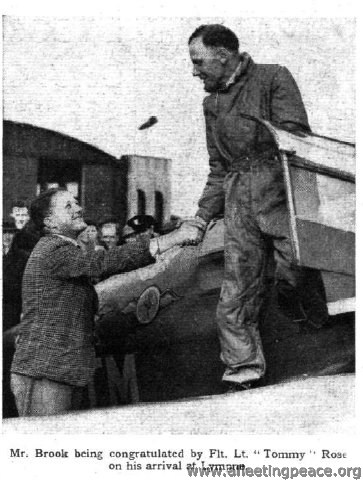
luck (no connection is suggested between the two facts!).Suffice it to say that the Australian trip, a large portion ofwhich was made in easy stages, took about twenty-six daysDuring his stay "down under," Brook worked until the" F a l c o n " and its engine were in tip-top condition beforestarting his almost unheralded flight.Of travelling in the "Falcon " he says that, compared withflying in an ordinary aeroplane with open cockpits, it was" like travelling in a saloon car instead of on a motor cycle. The veteran "Gipsy Major" was run throughout the flight at 2,100 r.p.m.
HILLSON PRAGA
Imported specimen 107 Praga E.114 OK-PGC. Regd G-ADXL (CofR 6479) 27.11.35 to F Hills & Son Ltd; dd Speke to Barton 30.12.35. CofV 91 issued wef 27.2.36. Dd 20.4.36 to Harold Leslie Brook; flown by him to South Africa, departing England 6.5.36; arriving Cape Town 22.5.36. Regn cld 6.36 as sold. Regd ZS-AHL 6.36 to OG Davies, Cape Town. Sold 8.37 to H Cooper, Cape Town. Converted to glider at Youngsfield 9.53.
30th Aug. 1940.
ADMINISTRATIVE AND SPECIAL DUTIES BRANCH.
The undermentioned are granted commissions for the duration of hostilities as Pilot Officers on probation:— 22nd May 1940.Harold Leslie BROOKE, D.C.M. (84353).
-
Campbell Black, Tom
-
Cathcart Jones, Owen
Lt Owen Cathcart Jones

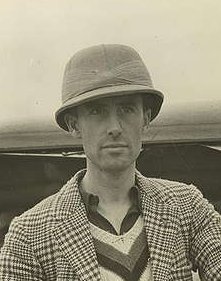 1934
1934 Born 5th June, 1900, London (definitely not Canadian, despite some nasty rumours).
McRobertson Centenary Gold Medal 1934
Royal Aero Club Silver Medal 1934
Holder of 8 Long Distance World Records. 1934
It's difficult to know what to make of Owen Cathcart-Jones, really; he was handsome, adventurous, undoubtedly talented, and clearly an excellent aviator - but, I'm afraid, rather prone to go 'AWOL' - both in his personal and service life!Born in London on 5 June 1900, he joined the Royal Marines in 1919, then, after the usual period of general service he volunteered for flying and joined R.A.F Netheravon on 12 January 1925, in the first batch of Marines officers to be transferred.
He was awarded his 'wings' in August 1925 and was posted to RAF Leuchars, serving with 403 Flight on HMS Hermes, and 404 Flight on HMS Courageous, taking a hand in the troubles in China in 1926-27 and again in Palestine in the following year.
In 1927, he wrote to The Times:
Sir,
On July 17 I had occasion to be flying down the east coast of Greece, and when in the vicinity of Mount Kissavos, near Larisa, I was astonished to see a large golden eagle fly past my aeroplane on a parallel course at a distance of about 80 feet away. The bird did not appear to be at all concerned at the noise of the engine, and in fact turned its head round to look at the aJrcraft on passing. The speed on my indicator showed 70 knots, and the height by my altimeter was 4,000 feet. Judglng by the speed at which I was passed by this bird, I should estimate that it must have been travelling at 90 mp.h.; which I consider to be quite a phenomenal speed for such a large bird at that high altitude.
Yours faithfully,
OWEN CATHCART-JONES,
Lieut. H.M.S. Courageous, at Skiathos, Greece, July 22.
which prompted Mr Seton Gordon, from the Isle of Skye, to reply:
Sir,
The letter from Lieutenant Owen Cathcart-Jones in The Times of July 27 which describes the great speed of a golden eagle in flight is of interest to me, as I have for some time believed the eagle to be one of the fastest birds. On one occasion I satisfied myself that an eagle was travelling at a good 120 miles an hour - probably much more -but then the bird was rushing earthward from a considerable height, and Lieutenant Owen Cathcart-Jones's bird was apparently on a level course. Little is definitely known even to-day as to the maximum speed any bird is capable of. Not so long ago a senior officer of H.M.S. Hood told us that when the Hood was steaming 34 miles an hour into a 15-mile-an-hour wind a formation of guillemots had no difficulty in forging ahead and crossing the vessel's bows. This interesting record shows that even the humble guillemot is capable of an air speed of well over 50 miles an hour, so a speed of 90 m.p.h. is not surprising in a bird of the wing power of a golden eagle.
I am, &c.,
During this time, he met Audrey, the wife of Captain Hugh Fitzherbert Bloxham, late of the Indian Army, then a Colonial Office official in the Prison Department at Hong Kong. Hugh and Audrey had married in St John's Cathedral, Hong Kong, on 6 August 1925.
Clearly Owen and Audrey got along rather well, and in November, 1927, their daughter Imogen was born.
Hugh duly sued Audrey for divorce in May 1928, "on the ground of her adultery, at the Hotel Savoy, Hong Kong, with Lieutenant Owen Cathcart-Jones, of the Royal Marines." The petition was uncontested.
On 12 Aug 1929 in Malta, Audrey had a son, Anthony.
"He established a reputation as a forceful and daring pilot, and one of his escapades became the talk of the Fleet; on 22 Aug 1929 he was on exercises with the Fleet and loaded his plane with a large packet of "service brown" toilet paper intending to drop it on H.M.S. Revenge which should have been last in the line. Unfortunately the C-in-C had inverted the line and he dropped the "bumph" very accurately on the Flagship, H.M.S. Queen Elizabeth. His Flycatcher aircraft was clearly numbered "7" and the Captain of H.M.S. Courageous was called to the Flagship on return to harbour to explain. Cathcart-Jones duly appeared before the Admiral with his reasons in writing [he made up some nonsense about it acting as a 'sighter' for actual bombs] and had to be on his best behaviour for some time."
On 26 November 1929 he made the first ever night deck landing in a fighter aircraft, flying a Fairey Flycatcher from H.M.S Courageous.
"It is a reminder of our one time presence in the Middle East that his record shows his Flight carrying out patrols in Palestine, and the Courageous Flights being shore based at Gaza and Aboukir in 1929 during the 'Civil War'.
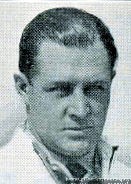
During his Fleet Air Arm service he became very friendly with a wealthy Naval Officer, Glen Kidston, with a similar passion for flying. Kidston was himself leaving the Navy and Cathcart-Jones decided that it was time to do likewise and to transfer his interests entirely to civil flying. He went on to half pay on 17 Febuary 1930 [for 6 months], joined National Flying Services Ltd. and never returned to the Service.
Audrey, by then aged 28, with Imogen (aged 2) and Anthony (aged 1) sailed from Brisbane to Plymouth on the P&O steamship Ballarat, arriving there on 21 Jan 1930.
On 21 April 1930, National Flying Services held their first display at Hanworth Park; Owen provided the finale by bombing a level crossing to bits. However, the meeting was not a success; "for some reason N.F.S. shows do not appeal to the average private owner" and crowds were poor.
In September 1931 he flew a D.H. Puss Moth, with Audrey as passenger, in the Deauville-Cannes Air Rally. After lunch and a gala dinner, they flew on to Cannes, despite a forced landing in the Alps when the fuel pipe and filter were found to be blocked with sand.
By the following May (1932), business was better; "taxi work is now on the increase and the N.F.S. pilots have been kept busy flying to places as widely separated as Plymouth and Berlin". Owen piloted G-ABTZ, a Stinson Junior belonging to Mr. E James, on several flights. On 31 July 1932, Audrey went on a conducted tour organised by NFS, of "eight Moths, one Bluebird and one Alfa Romeo", to Ostend.
Owen and Audrey lived in Tudor Court, Hanworth, London until 1934, but then Owen moved out, leaving her and the two children, who relocated to Wavenden, Bucks. In company with Kidston he broke 8 World records for long distance flights in 1934, including England to South Africa in a Lockheed Vega:

but Glen (centre) was killed in an air crash shortly afterwards.
Owen also came 6th in the 2nd Morning Post Cross-country Air Race on 6 June 1933, and competed in the King's Cup in 1934 (finishing 9th) and 1935 (when he came a creditable 3rd).
Here he is, wandering around waiting to take-off, and taking a pylon in the final of the King's Cup 1934:
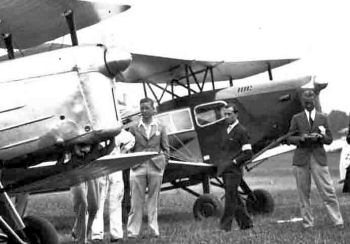
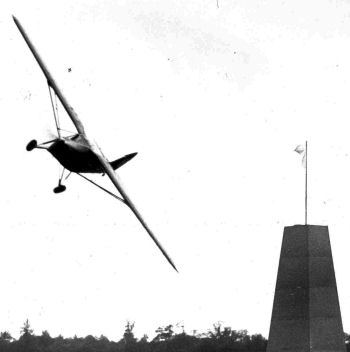
His real moment of glory was to co-pilot with Ken Waller the specially built D.H. Comet in the 1934 McRobertson England to Australia Centenary air race, in which they were awarded third prize in the Speed Handicap. On arrival they immediately turned round and flew back to England and established a record for the round trip.
Originally, he had teamed up with Miss Marsinah Neison in a Lockheed Altair (or Vega), "placed at their disposal by the builders", or possibly a Northrop Delta. However, nothing came of this.
He certainly wasn't first choice as Comet pilot - Bernard Rubin, the owner and intended pilot of the aeroplane, fell ill and originally nominated as substitute Mr Smirnoff 'the well-known Dutch pilot' on October 1st, and then only on October 5th (2 weeks before the race) 'finally and irrevocably' decided it should be Owen who accompanied Ken Waller. Three weeks before the Race, Owen had "never heard of Mr Rubin or Mr Waller", but apparently Marsinah said "Seajay, why don't you try and take Rubin's place?" Owen considered this a "most sporting action" on her part, but this meant that he had very little time to familiarise himself with the notoriously-tricky aeroplane.
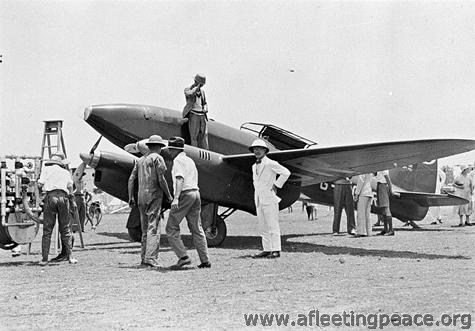
After the return trip from Australia, Owen said "We have averaged 10 hours' flying every day, and covered approximately 2,200 miles a day. We wanted to make this flight back not so much as a speed flight, but as a flight which could be copied for commercial purposes. We have flown only by day, and have had time to sleep, eat, and wash. From the commercial point of view I think there is no reason why there should not be a service between Melbourne and England on similar times to those we have taken, certainly for the carrying of mails.
People in the Colonies were very anxious to have their letters quickly and to have air-mail services covering the distance in so short a time. We had one nasty moment at Allahabad, when we had trouble with two of the cylinders, but the Mollisons came to the rescue and lent us spare parts - a very sporting action. We were greatly disappointed by the delay at Athens owing to bad weather conditions, which prevented us from getting to Lympne yesterday."
Messages of congratulations included this one: "The Duke of Gloucester directs me to congratulate you both on a magnificent double flight - Private Secretary, Duke of Gloucester.
However, even while he was away, the law was after him: "ENGLAND-AUSTRALIA AIR PILOT SUMMONED. Flight Lieutenant Owen Cathcart Jones, of the Naval and Military Club, Piccadilly. who is taking part in the air race to Australia, was summoned at Bow Street Court yesterday, on a charge of using a motor-car with an expired Road Fund licence. He did not appear, and on being informed that Lieutenant Jones was one of the competitors in the England-Australia race, Mr Dummett adjourned the summons sine die."
In 4 April 1935, several visitors arrived by air for the Norfolk and Norwich Annual Dinner, including " Lt. O. Cathcart-Jones and Miss M. Neison in a Puss Moth".
He published his "Aviation Memoirs" in 1935; "... breezy, light and interesting... the book is unusually well illustrated, with photographs which Mr. Cathcart Jones has collected or taken himself, and many of these photographs are extremely graphic and educative." Interestingly, Owen rather neglects to mention anything about his wife and children.
In 1935, Ken Waller got annoyed with him for something he said in this book that Ken felt "reflected on his courage and ability as a pilot", and even went to court over it. Owen replied that "that was the last thing he intended, as Mr. Waller and he had been, and still were, very good friends", which seemed to settle the matter.
Reading the memoirs, I can only assume this was the passage where, having got themselves lost in bad visibility over Arabia during the Race, Owen says that "little did I know that Ken was on the point of asking me to dive the machine into the ground and get it all over rather than face the possibility of running out of petrol, forced landing in the sand, where we certainly would have smashed the machine, and then lie there slowly dying without means of help."
In fact, Owen's is a rather bland account of their two-way trip, and at one point Owen credits Ken with a 'marvellous achievement'; "Ken, under great difficulties, made a superb landing".
Also in 1935, he drove a 4.5 litre Lagonda Rapide in the Monte Carlo Motor Rally, starting from Stavanger in Norway. He was the first competitor to arrive in Monte Carlo, and was thought to have a good chance of winning the first prize, but was eventually placed 34th. His 'second-in-command' was a Miss Marsinah Neison, "one of the very few women to hold a 'B' licence for aircraft".
Owen and Marsinah got up to quite a few things together:
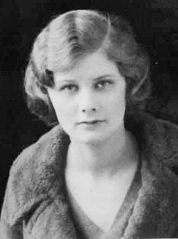
Beatrice Marsinah Neison, b. 3 Dec 1912 in Reigate. She gained her RAeC certificate at National Flying Services, Hanworth on the 11 Jan 1932, and passed the night-flying test in September.
Owen says of her "a young commercial pilot came to me for some advanced flying instructions, and I was very much impressed with the exceptional ability shown by her. Miss Marsinah Neison was the youngest girl pilot to get the coveted 'B' commercial pilot's licence. She qualified for it at the age of nineteen." He reckoned "there was very little I could teach her... I decided that her abilities were far too high to waste, and asked her to join me in any free-lance air charter work in which we could combine".
I'm not suggesting anything untoward, you understand...
In November 1933, she was trying to raise finance for a solo flight to Australia in a Comper Mouse, to beat the record held at the time by CTP Ulm, but never did.
Here she is, ready to go:
She sailed to California in May 1936, to visit her friend 'Russell Pratt', (sounds like an assumed name to me...) and to New York in July 1937. She married Hart Lyman Stebbins of New York 'very quietly' in London in December 1937, (they appear in the 'New York Social Register', whatever that means, for 1941), then Angus MacKinnon in July 1947. She died 29 April 1997 in Hampshire (England).
Anyway, Owen was by now pretty well-known; in May 1935, for example, he, Mrs Mollison (Amy Johnson), Tom Campbell Black, and other aviators took part in a 'Mock Trial', in aid of King Edward's Hospital Fund for London, at the London School of Economics; they were charged with 'Making the world too small'. The following August, he was chief pilot in the 'Jubilee Air Display', also with Tom Campbell Black.

 via Joss Mullinger
via Joss Mullinger"Lieut. Owen Cathcart-Jones and Mr. T. Campbell Black, two of the keenest rival prize-winning pilots in the great England-Australia Air Race last year, are combining in a brilliant partnership to take a leading part in the Jubilee Air Display which will be given at Home Farm, Tehidy, Camborne, Thursday, August 15th. 2.15 till dark. The display which is visiting no fewer than 180 centres throughout Great Britain during the summer months, has been specially planned to provide a striking demonstration of the supremacy of British modern commercial aircraft and the unrivalled skill of British pilots. Public interest in aviation has never been more keen than it is at the present moment."
Don't be fooled into thinking you might have flown in the D.H. Comet, though - Owen flew passengers in a four-seat G.A.L. Monospar, and Tom took them up in an Avro Cadet, a rather pedestrian trainer.
On 31 July 1935, Owen advertised, again in The Times: "Mr Owen Cathcart-Jones requires sponsor to finance building world's fastest commercial aeroplane for nine special long-distance record flights in 1936-7 showing profitable return."
Nothing came of this either...
By December that year, however, Owen was banned from flying in Argentina because of his 'stunts'near a military aerodrome; the following April, his aeroplane was impounded by the Austrian authorities and he had to make his own way back home via Cannes.
Gigi Jakobs tells me that "I came across his name in divorce proceedings for Robin W.G. Stephens and Phyllis Gwendlen (nee Townshend) Fletcher. They started divorce proceedings in late 1936 because, according to Stephens, his wife had committed adultery with Cathcart Jones from Dec 1935 to May 1936."
26 Jan 1937
"Owen Cathcart Jones, the well-known airman, of Grosvenor Street, London, failed to appear at his first meeting of creditors at the London Bankruptcy Court to-day. The assistant official receiver stated fhat the debtor had failed to surrender under the proceedings. A distress was levied at his flat last December, and goods sold in January. A representative of the petitioning creditor said that the debtor took an aeroplane to South America for demonstration purposes. The debtor sold the machine and failed to account for the proceedings, and a judgment for £660 had been obtained against him. Mr Newman said that the debtor in August last was alleged to have landed in Czechoslovakia with two Spanish Nationals, and subsequently disappeared. Whether he is in Spain or not I don't know." said Newman, "but I believe he was in this country December 22 last." The case was left the hands of the Official Receiver as trustee."
The bankrupcy hearing was first delayed, then postponed indefinitely; Owen didn't turn up for any of the meetings.
He somehow became an instructor at the London Air Park Flying Club at Hanworth, an elite government-subsidized club for wealthy patrons. His fellow-instructors included David Llewellyn and Ken Waller.
Five years later, he was, somehow, a Squadron Leader in the Royal Canadian Air Force:
"In March of 1942 he was posted to Western Air Command Headquarters, but nothing is recorded in the WAC HQ diary to confirm this or indicate duties. He was then ‘Posted to ABS’ (Absent), 29 April 1942. It appears that he had gone AWOL (Absent Without Leave), as the diary of Headquarters, Western Air Command, under date of 6 July 1942, read in part, ‘Squadron Leader O.Cathcart-Jones who has been AWL for some time, returned from California to this Headquarters under escort.’ He is then shown as taken on strength of Western Air Command Headquarters, 6 July 1942. Two months later, he was ‘Retired’ from the RCAF”.
Hugh Halliday fills in some background:
"He was living in Mexico City in April 1940 when he applied to the RCAF and was duly commissioned in that force on 16 May 1940 (Pilot Officer, simultaneous promotion to Flight Lieutenant). He was assigned to the Air Member for Operations and Training, AFHQ, and performed well enough that he was promoted to Squadron Leader, 1 June 1941. The timing of this suggests (but I cannot prove it) that he was advanced in rank to give him more credibility with American authorities.
In April 1941 he was sent to California on temporary duty as Special Advisor to Warner Brothers for the film “Captains of the Clouds”. The RCAF paid him a special allowance of $ 10.00 a day for the time he was there. He seems to have considered California a bit of a “hardship posting” because of high costs and a depreciated Canadian dollar. He nevertheless wrote to people at AFHQ (Ottawa) on Warner Brothers stationery, at one point urging that he not be forgotten when operational postings were distributed. As of 20 February 1942, Hal Wallis (Director of the film) was effusive in his praise of Cathcart-Jones both in production and publicity preparation. His services with Warner Brothers apparently ended that day.
On 4 March 1942 he reported back to the RCAF on posting to Western Air Command Headquarters (Victoria, British Columbia). About a month later he was advised that he was to be posted to Station Alliford Bay as Operations Officer. A remote station in the Queen Charlotte Islands, it might nevertheless have been deemed to be in a zone of potential intense operations, given the panic that had engulfed the West Coast following the opening of the Pacific War. Cathcart-Jones would have nothing to do with it. He pleaded personal difficulties – privately he stated that he regarded Alliford Bay as a backwater – and he argued for assignment to Seattle as a Liaison Officer. On 27 April 1942, Group Captain A.D. Hull (WAC Headquarters), having interviewed Cathcart-Jones, wrote, “Squadron Leader Cathcart-Jones has undoubtedly ability. However, he appears to put his personal affairs before the Service. Should be closely supervised on new posting and given an opportunity to prove his initiative and worth.”
The same day (27 April 1942) he was issued a travel warrant to travel from Victoria to Vancouver and thence to Alliford Bay. By then he had cleared out his Victoria apartment and disposed of his books. He took the boat to Vancouver. On 28 April 1942 he crossed the border into the United States, in uniform, stating that he was on RCAF duty to the Fourth Interception Command, and that he was waiting for orders from Ottawa. He then hastened on to Hollywood.
On 29 April 1942 he wrote to Western Air Command Headquarters, submitting a resignation from the RCAF. Since he was already a deserter, the “resignation” was not accepted. In June 1942 he was arrested by American authorities, charged with having made false and misleading statements on entering the United States. He sent a message to WAC, asking that confirmation be sent that he was in California on RCAF Liaison Duty. This, of course, could not be provided (one is struck by the man’s sheer cheek). He was returned under arrest to Canada, reporting back to WAC Headquarters, and his case reviewed in detail on the 9th. Among the issues disputed were his debts ($ 884.09) and whether he should be “retired” or be allowed to resign his commission (his preference). He was retired. It was deemed that a General Court Martial for an AWOL case was “over the top” – he just was not worth it. He had not been paid since the day he went AWOL."
During his time with the RCAF he designed a board game, for which he did all the artwork; he was then involved in The Movies (Technical Director, and a 30-second appearance as 'Chief Flying Instructor' in 'Captain of the Clouds', of which Flight said " it is a first-class production in almost every respect" ).
See the excellent article on Vintage Wings of Canada's website.
He then got mixed up in some tawdry goings-on with Errol Flynn and a Miss Peggy Satterlee..
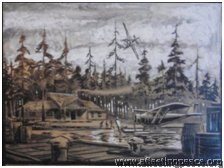
"This painting was done by Squadron Leader Owen Cathcart- Jones when he was an advisor on the movie 'Captains of the Clouds'. He also played a part in the movie. The painting shows the Hudsons Bay Co. trading post where the movie was filmed. When my father-in-law was ten years old, Cathcart-Jones gave him this lovely painting."
with thanks to http://relicsandtales.blogspot.com
He eventually bought a ranch to raise polo ponies, and became President of the Polo Club in Santa Barbara.
His daughter Imogen married John Otis Thayer (from Boston, Massachusetts) in September 1947. She was described as 'the daughter of Mrs A Cathcart-Jones of Wavedon, Bletchley, Buckinghamshire'.
Audrey died in 1962; her son Anthony in 2005.
In 1981, he wrote to 'Flight' "I had a bad accident at polo when I was knocked from my horse and fell on my head, but I am now almost completely recovered and back playing polo again."
Owen died February 1986, in California, aged 85.
Postscript
Imogen's son David actually met him: "Owen lived at 305 San Ysidro Rd., in Montecito. His ranch was about 4 acres at the end of a long driveway that passed through avocado orchards owned by the people who lived down on the road. It's been sub-divided and developed.
Some years ago, I walked up the driveway to discover that his house had been replaced by a large, pink, stucco hacienda and there's a second house, next-door, where his riding ring was. The avocado orchards down by San Ysidro Rd., are gone, too.Owen's sixth wife, and widow sold the place and moved to La Jolla a couple of years after he died. She died three or four years ago.
Imogen was reconnected with her father in the early 50s - he came to visit in 1952 and they wrote and phoned, after that.In the summer of 1965, my parents and their five kids drove out to Montecito, in a camper, and spent about a week at Owen's, just before he married his sixth ? wife, Pat, in August 1965.The following summer, 1966, I went out to visit him for two weeks, and was stranded in Montecito, for the whole summer, because of an airline mechanics strike which grounded the major airlines for 50+ days!It was great fun. My grandfather had to put me on the Continental Trailways bus, in September, to get me back to New York, in time for the first day of school.Owen had a second son, Colin, with his wife, Elizabeth Toomey, who he wooed away from her husband, in Buenos Aires, in 1936. She was married to a Mr. Waterman, who was, according to my grandfather's widow, Pat, the heir to the Waterman ink company. They married and had a son, in England, and came to NY soon after the boy was born. Evidently, in NY, he got involved with Marsinah Niesen, who was there and married to a Mr. Stebbins, and my grandfather walked out on Bette, leaving poor Bette to raise Colin in Queens, NY, with the help of her parents! She got no support from Owen.We have a January 1939 letter, from Colin's mother to my grandmother, Audrey, with her reaction to the news that Owen and my grandmother had not actually been divorced, though we do have a "Deed of Separation" which, I guess, is the precursor to divorce, in England.Bette Toomey Cathcart Jones had written to my grandmother for an affidavit of divorce so that she could proceed with her divorce from Owen. We have my grandmother's draft of the letter that she sent to Bette that prompted this response and my grandmotherher mentions Marsinah as one of the principals in her separation from Owen.Colin CJ died last January [2013]. We had Owen's passport with his and Bette Toomey's photos and Colin's name written in. I looked him up on the Internet and telephoned. We planned to meet but never got the chance. I spoke to him, just a year ago, on his birthday. November 13th." -
Cobham, Alan John
Mr (Sir) Alan John Cobham KBE AFC
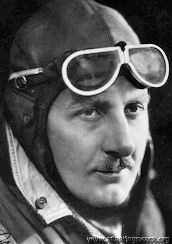 in c.1934, aged c.40
in c.1934, aged c.40
Page 2 of 3

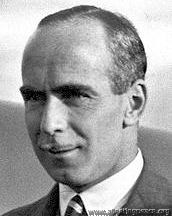 photo: 1934
photo: 1934

